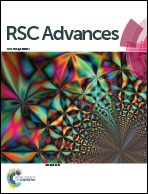A facile microwave-assisted approach to the synthesis of flower-like ZnCo2O4 anode materials for Li-ion batteries
Abstract
A simple and rapid microwave-assisted hydrothermal (MH) method is used to synthesize spinel-based ZnCo2O4 anode material for Li-ion batteries. Microwaves provide a uniform and rapid formation of the oxide at a low temperature of 190 °C for a short reaction time of 15 minutes. The crystallinity, pore size distribution, surface morphology and characteristics, crystal structure, surface morphologies and electrochemical properties of ZnCo2O4 (ZCO) are carried out by using X-diffraction (XRD), Brunauer–Emmett–Teller (BET) analysis, scanning electron microscopy (SEM), transmission electron microscopy (TEM), cyclic voltammetry, impedance and cyclic performance, respectively. The initial discharge capacity of microwave-ZCO (M-400) is 1510 mA h g−1, at a current rate of 100 mA g−1. After 30 cycles, the M-400 sample delivers a reversible capacity as high as 1334 mA h g−1 at 100 mA g−1. For 10C tests, M-400 demonstrates a capacity of more than 605 mA h g−1, which is superior to that of conventional ZCO samples synthesized by hydrothermal reaction (C-400). In subsequent cycles, the capacity of M-400 recovers to 1664 mA h g−1 with the current density back to 0.1C and the diffusivity was higher than C-400 by ∼18 times. The comparable high capacity of the MH method indicates that it could be a viable route to easily synthesize spinel oxides.



 Please wait while we load your content...
Please wait while we load your content...